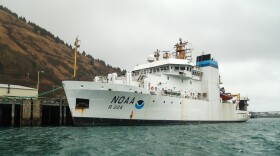There are a lot of breweries in Anchorage focused on creating the perfect ales and IPAs. And to entice customers to visit and linger at their establishments, many partner with food trucks.
Latest News & Local Programs
-
At least 36 servicemen were buried at the Fort Randall Post Cemetery on the Alaska Peninsula.
-
Body camera footage of the Feb. 21 incident shows 41-year-old Puipuia Alaelua holding a woman on top of himself, with a gun pointed at her, before police shot and killed him.
-
Phil Huebschen said they were “unable to authentically engage” in removing DEI language from the council’s website, under Trump administration pressure.
-
Sen. Dan Sullivan says the Fighting Foreign Illegal Seafood Harvest Act, which he co-sponsored, relies on National Oceanic and Atmospheric Administration efforts.
-
The pollen is a trigger for those with seasonal allergies, who may want to limit time outside or find ways to manage exposure.
-
An emergency declaration by the Board of Game does not change the fact that the program is unconstitutional and the state failed to do required fixes, the judge ruled.
-
The state medical examiner's office positively identified a body found last week as 21-year-old Devin Standifer. No foul play is suspected in his death.
-
The roughly $5 to $6 million the city receives in marijuana taxes annually will go towards covering child care costs for those working in the sector, as well as projects aimed at expanding existing programs.
-
Lawmakers react to Gov. Dunleavy's threat to veto an education funding boost unless legislators include his policy changes.
-
Gov. Mike Dunleavy is demanding the Legislature pass additional education policy changes, or he'll veto a compromise bill that passed with wide support, superintendents said.
Thanks to our sponsors
Upcoming Events
Join Alaska Public Media for a fun, free evening of news trivia, brews and bites at Cynosure Brewing.
A free, family-friendly event where kids explore salmon science and culture with Molly of Denali through games, videos, and hands-on activities.
More from AKPM
Take a trip up north with these local stories from Alaska Public Media.



















